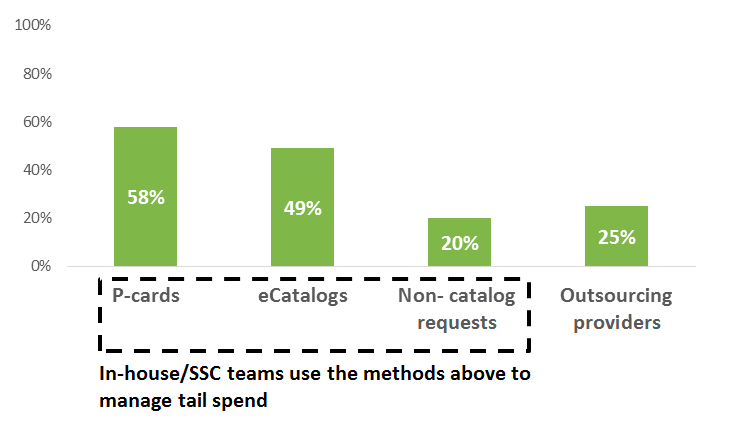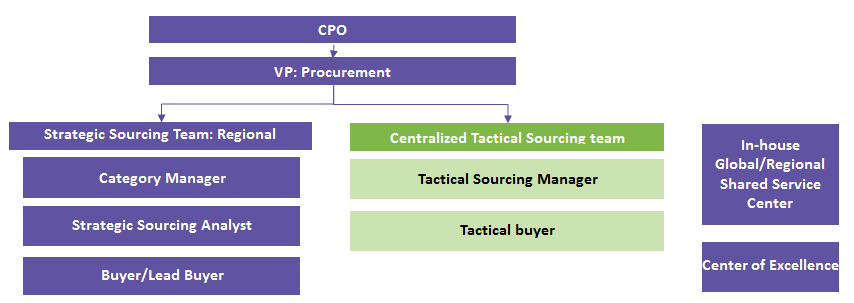
In-house Tail Spend Management Outsourcing Using AI Tools

Abstract
In the era of outsourcing tactical procurement activities, performing tactical tasks in-house/in shared service centers (SSC) using advanced systems and achieving equivalent results can showcase the efficiency of the organization's procurement process. A stand-alone tactical team that can handle all transactional and operational procurement tasks in a global in-house/in-SSC setup is vital to clearly differentiate and define the roles and responsibilities of each full time employee (FTE) in the team. However, this team does not necessarily work under the strategic team. Strategic and tactical teams should be viewed like two sides of the same coin, working together to achieve the company's goals.
This article throws light on two key aspects: What does a best-in-class in-house tactical team look like? And how can organizations with an in-house tactical team compete with other organizations that outsource tactical procurement, ensuring equivalent performance and results using automation and artificial intelligence (AI) systems and tools?
|
Key Highlights |
|
How Do Companies Manage Their Tail Spend?

- Organizations are identifying solutions that can bring back undermanaged spend within a centralized view by adopting purchasing cards (58 percent), which can help in consolidating buying by departments.
- Another common method is through eCatalogs, which has been implemented by half of the procurement groups (49 percent) to manage buying requests that might otherwise be executed without consulting the procurement department at all.
- Twenty five percent of procurement groups are looking at outsourcing providers to help manage their non-contracted goods purchase, utilizing external technology and expertise to control wasteful and hard-to-track expenditures.
Tactical Operations: In-house/SSC vs Outsourced
Most companies with global operations in the CPG, pharma, and manufacturing industries have their tactical buying workload managed centrally by a central tactical sourcing team or shared service center, separated from the strategic sourcing team.
|
Description |
Adoption level of best-in-class companies across industries: Medium to high |
Adoption level of best-in-class companies across industries: High |
| Model 1 | Model 2 | |
|
Centralized in-house team / shared service center
|
Outsourcing Company
|
|
|
Activities performed |
Centralized tactical sourcing team to handle all non-core, niche, and one-time category purchases and catalog management
|
Non-judgment-intensive, less strategic, and non-core categories, along with transactional and repetitive activities that consume time, resources, and effort are delegated to a third party |
|
Pros |
|
|
|
Cons/Challenges
|
|
|
|
When to consider? |
|
|
The In-house Tactical Team’s Structure and Governance
Key direct and indirect categories have their own sourcing strategies and teams, which ensures higher cost savings. For cost savings of 7–12 percent in the tail spend as well, it is vital to alter the organization structure.
Best-in-class companies that manage tail spend in-house build a global or regional team depending on their tail spend and the size of their supply base across regions.

The operational work (shared service center) and market Intelligence (center of excellence) are placed at a central location for better standardization and sharing of best practices.
Note: The tactical souring team could be in-house or operating from the company’s near-shore/off-shore shared service center.
Roles and Responsibilities of the Tactical Team
A small dedicated team with one tactical sourcing manager, two–three tactical buyers, and one procurement executive is found in many companies.
|
Location |
Designation |
Roles |
| Global |
Tactical Sourcing Manager |
|
|
Tactical Buyer |
|
|
|
Procurement Executive |
|
How Can Advanced P2P Systems with Robotic Process Automation and AI Capability Support In-house/SSC Teams?
|
Procurement Process |
Robotic Process Automation (RPA)/AI |
How do RPA/AI Technologies Add Value to Companies? |
|
Catalog/Content management |
Both |
|
|
Purchase order preparation and management |
RPA |
|
|
Invoice, payments, and claims management |
RPA |
|
|
Supplier performance management |
AI |
|
Conclusion
There is a perception that the cost of carrying out procurement services in-house is high and its efficiency is lower than that obtained by outsourcing the services. This is correct to an extent. However, the benefits of deploying AI and RPA-powered P2P tools will eventually offset the high costs of maintaining an in-house tactical team.
Organizations that lack sufficient resources, skills, and budget to carry out tactical activities completely in-house can opt for a tailored outsourcing model, where few services are offered by service providers while others are carried out in-house, with considerable integration of the two approaches. For example, Xchanging will operate on a co-sourcing basis alongside L’Oréal’s purchasing team to streamline its purchasing processes and improve overall quality and cost.
References
https://bellwethercorp.com/tactical-procurement-in-your-organization/
Related Insights:
View All
Get more stories like this
Subscirbe for more news,updates and insights from Beroe







